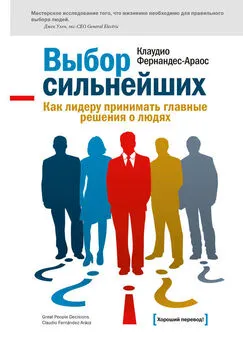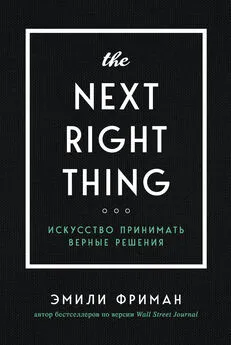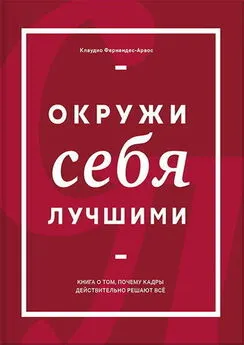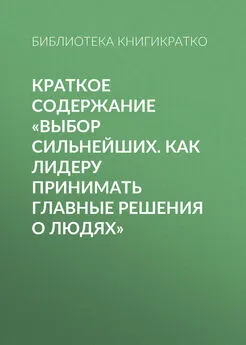Клаудио Фернандес-Араос - Выбор сильнейших. Как лидеру принимать главные решения о людях
- Название:Выбор сильнейших. Как лидеру принимать главные решения о людях
- Автор:
- Жанр:
- Издательство:Литагент МИФ без БК
- Год:2016
- Город:Москва
- ISBN:978-5-91657-438-8
- Рейтинг:
- Избранное:Добавить в избранное
-
Отзывы:
-
Ваша оценка:
Клаудио Фернандес-Араос - Выбор сильнейших. Как лидеру принимать главные решения о людях краткое содержание
Выбор сильнейших. Как лидеру принимать главные решения о людях - читать онлайн бесплатно ознакомительный отрывок
Интервал:
Закладка:
182
Daniel Goleman, Social Intelligence: The New Science of Human Relationships (Bantam Books, 2006), p. 98.
183
Robert W. Eder and Michael M. Harris, The Employment Interview Handbook (Sage Publications, 1999). See Chapter 14, “Are Some Interviewers Better Than Others?” by Laura M. Graves and Ronald J. Karren, pp. 243–258.
184
E.D. Pulakos, N. Schmitt, D. Whitney, and M. Smith, “Individual Differences in Interviewer Ratings: The Impact of Standardization, Consensus Discussion, and Sampling Error on the Validity of a Structured Interview,” Personnel Psychology 49, 1996: 85–102.
185
Robert L. Dipboye and Kenneth E. Podratz, “Estimating Validity at the Level of the Interviewer: The Case for Individual Differences,” Rice University, PowerPoint presentation accessed through Google, August 2006.
186
R. Taft, “The Ability to Judge People,” Psychobgical Bulletin 52, 1955.
187
P.M. Rowe, “Unfavorable Information and Interviewer Decisions,” in The Employment Interview: Theory, Research and Practice, edited by R.W. Eder and G.R. Ferris (Thousand Oaks, CA: Sage, 1989).
188
Valerie I. Sessa and Jodi J. Taylor, Executive Selection: Strategies for Success (Center for Creative Leadership, Jossey-Bass/Wiley, 2000), p. 88.
189
R.W. Eder and M.R. Buckley, “The Employment Interview: An Interactionist Perspective,” in Research in Personnel and Human Resource Management, 6th ed., edited by G.R. Ferris and K.M. Rowland (Greenwich, CT: JAI Press, 1988).
190
Интернет-издание корпоративного журнала THE FOCUS online ( http://www.ezifocus.com/content/thefocus/issue/article.php/article/54300471), vol. X/l, 2006. Авторская тема номера – Jim Collins: “Filling the Seats: How People Decisions Help Build a Great Company.”
191
Из частной беседы с Говардом Стивенсоном, Буэнос-Айрес, июнь 2006 г.
192
Из частной беседы с Джеком Уэлчем, Бостон, февраль 2006 г.
193
Jerry Useem, “Have They No Shame?” Fortune, April 14, 2003: 57.
194
Laura Nash and Howard Stevenson, Just Enough (Hoboken, NJ: John Wiley & Sons, 2004), p. 45.
195
“CEO Pay: A Window into Corporate Governance,” Knowledge@Wharton, February 8, 2006 ( http://knowledge.wharton.upenn.edu/article.cfm?articleid=1481).
196
“SEC’s Spotlight on Executive Pay: Will It Make a Difference?” Knowledge@Wharton, May 17, 2006. ( http://knowledge.wharton.upenn.edu/article.cfm?articleid=1481).
197
James Surowiecki, The Wisdom of Crowds (Doubleday, June 2004), pp. 113–114.
198
Jeffrey Pfeffer and Robert I. Sutton, Hard Facts, Dangerous Half-Truths, and Total Nonsense (Harvard Business School Press, 2006), p. 133.
199
Daniel Goleman, Social Intelligence. The New Science of Human Relationships (New York: Bantam/Dell, September 2006), p. 271.
200
Dan Baker, Cathy Greenberg, and Collins Hemingway, What Happy Companies Know (Pearson Prentice Hall, 2006), p. 62.
201
Описание потенциальной выгоды компенсационной системы по принципу «все как один» содержится в статье “A Simpler Way to Pay,” Harvard Business Review , April 2001: 53–61.
202
Marshall W. Van Alstyne, “Create Colleagues, Not Competitors,” Harvard Business Review, September 2005: 24.
203
Valerie I. Sessa and Jodi J. Taylor, Executive Selection: Strategies for Success (Center for Creative Leadership, Jossey-Bass/Wiley, 2000), p. 48.
204
Jeffrey Pfeffer and Robert I. Sutton, Hard Facts, Dangerous Half-Truths, and Total Nonsense (Harvard Business School Press, 2006), p. 123.
205
THE FOCUS online ( http://www.ezifocus.com/content/thefocus/ issue/article.php/article/54300471), vol. X/l, 2006. Заглавная тема номера Jim Collins: “Filling the Seats: How People Decisions Help Build a Great Company.”
206
Из частной беседы с Джеком Уэлчем, Бостон, февраль 2006 г.
207
Marshall W. Van Alstyne, “Create Colleagues, Not Competitors,” Harvard Business Review, September 2005: 28–30.
208
Jeffrey Pfeffer and Robert I. Sutton, Hard Facts, Dangerous Half-Truths, and Total Nonsense (Harvard Business School Press, 2006), p. 196.
209
Полет в космос «Аполлона-13» был впоследствии отмечен в одноименном кинофильме Рона Говарда (1995 г.)
210
Valerie I. Sessa and Jodi J. Taylor, Executive Selection: Strategies for Success (Center for Creative Leadership, Jossey-Bass/Wiley, 2000), p. 94.
211
John J. Gabarro, The Dynamics of Taking Charge (Harvard Business School Press, 1987), Chapter 1, Introduction, p. 1.
212
“Bio-Tech CEO Survey 2005: The First 100 Days,” Egon Zehnder International.
213
“That Tricky First 100 Days: Executive Onboarding,” The Economist, July 15, 2006.
214
Daniel Goleman, Social Intelligence: The New Science of Human Relationships (Bantam Books, September 2006), p. 271.
215
H. Mintzberg, “Managerial Work: Analysis from Observation,” Management Science 18(2), 1971: B97–B110.
216
John J. Gabarro, The Dynamics of Taking Charge (Harvard Business School Press, 1987), p. 57.
217
Valerie I. Sessa and Jodi J. Taylor, Executive Selection: Strategies for Success (Center for Creative Leadership, Jossey-Bass/Wiley, 2000), Preface, p. XIV.
218
Jay A. Conger and David A. Nadler, “When CEOs Step Up to Fail,” MIT Sloan Management Review 45(3), spring 2004.
219
Kevin P. Coyne and Bobby S.Y. Rao, “A Guide for the CEO-Elect,” The McKinsey Quarterly 3, 2005: 47–53.
220
“Financial Services 2005 Survey: The First Three Months of CEOs,” Egon Zehnder International, unpublished work.
221
Tsun-Yan Hsieh and Stephen Beat, “Managing CEO Transitions,” The McKinsey Quarterly 2, 1994.
222
Daniel Goleman, Social Intelligence: The New Science of Human Relationships (Bantam Books, September 2006), p. 43.
223
Daniel Goleman, Social Intelligence: The New Science of Human Relationships (Bantam Books, September 2006), p. 63.
224
Daniel Goleman, Social Intelligence: The New Science of Human Relationships (Bantam Books, September 2006), p. 64.
225
Stephen J. Dorgan, John J. Dowdy, and Thomas M. Rippin, “Who Should and Shouldn’t Run the Family Business,” The McKinsey Quarterly 3, summer 2006: 13–15.
226
Bill Frymire, “The Search for Talent (Why It’s Getting Harder to Find),” The Economist, October 7, 2006.
227
Возможно, это кажется преувеличением, но в действительности это правда. Жизнь в постоянном стрессе излишне стимулирует лобную долю коры правого полушария головного мозга, которая посредством вовлечения сложных механизмов активизирует симпатическую нервную систему и повышает артериальное давление, выделяет в излишних количествах кортизол и адреналин, тем самым ослабляя иммунную систему организма и повышая риск сердечно-сосудистых заболеваний, диабета и даже рака.
228
Jack Welch and Suzy Welch, “Ideas – The Welch Way: The Real Verdict on Business,” BusinessWeek, June 12, 2006.
Интервал:
Закладка:










